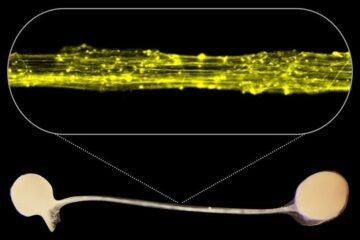Researchers discover female spiders produce mating plugs to prevent unwanted sex from males

In the giant wood spider Nephila pilipes, a highly sexually dimorphic and polygamous species, many small males compete with one other for access to a few huge females. During copulation these males are known to sever their own genitals in an attempt to plug the female, thereby gaining paternity advantage by preventing other males from mating with her.
Until recently however, nothing has been known about the origin and function of additional and very solid plugs researchers have observed that also commonly cover female genitals in this species. Now biologists have discovered the origin of this additional other plugging mechanism.
The international team of scientists who published their findings in the July 19 issue of the journal PLoS ONE, consists of Matjaž Kuntner, research associate at the Smithsonian's National Museum of Natural History and chair of the Institute of Biology at the Scientific Research Centre, Slovenian Academy of Sciences and Arts; Daiqin Li, associate professor at the Department of Biological Sciences, National University of Singapore, and doctoral students Matjaž Gregoriè and Shichang Zhang, and postdoc Simona Kralj-Fišer.
Before the trials the researchers speculated that the additional mystery plugs commonly found covering female genitals might be produced by the copulating male, or the female, or perhaps both spider sexes. The researchers tested these possibilities by staging laboratory mating trials with varying degrees of females mating with multiple males. They observed that no plugs were ever formed during mating trials, but instead, females exposed to many males produced the amorphous plugs during the egg-laying process.
These plugs, when hardened, prevented subsequent copulation. The authors conclude that the newly discovered “self-plugging” mechanism represents a female adaptation to sexual conflict through the prevention of unwanted and excessive copulations.
Media Contact
More Information:
http://www.si.eduAll latest news from the category: Life Sciences and Chemistry
Articles and reports from the Life Sciences and chemistry area deal with applied and basic research into modern biology, chemistry and human medicine.
Valuable information can be found on a range of life sciences fields including bacteriology, biochemistry, bionics, bioinformatics, biophysics, biotechnology, genetics, geobotany, human biology, marine biology, microbiology, molecular biology, cellular biology, zoology, bioinorganic chemistry, microchemistry and environmental chemistry.
Newest articles

Caution, hot surface!
An international research team from the University of Jena and the Helmholtz Institute Jena are demystifying the mechanisms by which high-intensity laser pulses produce plasma on the surface of solids….

Exploring the Asteroid Apophis With Small Satellites
In five years’ time, a large asteroid will fly very close to Earth – a unique opportunity to study it. Concepts for a national German small satellite mission are being…

First model of the brain’s information highways developed
Our human brain is not only bigger and contains more neurons than the brains of other species, but it is also connected in a special pattern: Thick bundles of neurons…





















